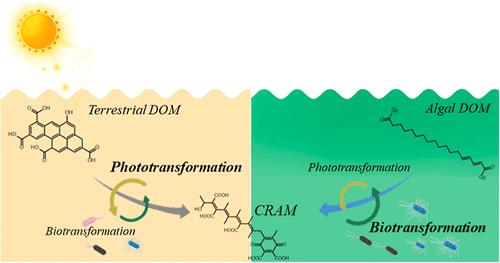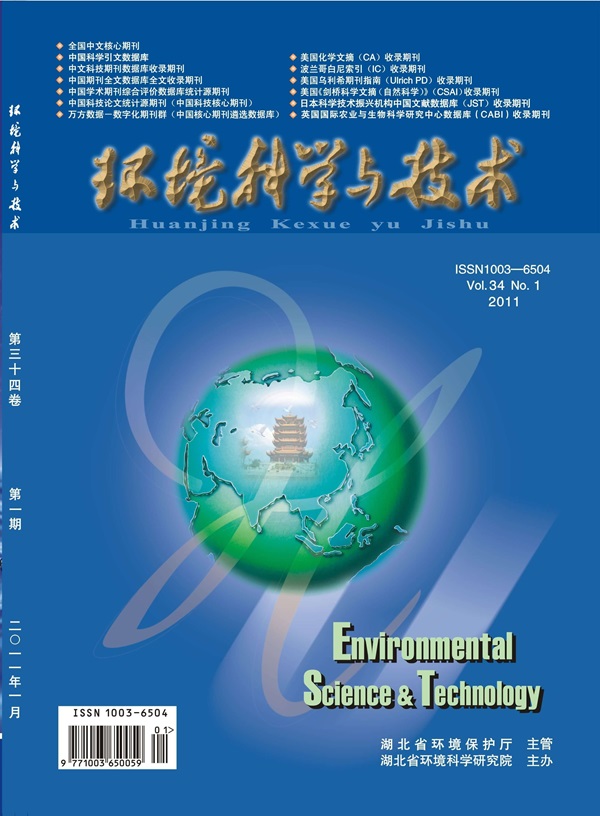Long-Term Photochemical and Microbial Alterations Lead to the Compositional Convergence of Algal and Terrestrial Dissolved Organic Matter
IF 10.8
1区 环境科学与生态学
Q1 ENGINEERING, ENVIRONMENTAL
引用次数: 0
Abstract
Lakes are expected to become more active in processing dissolved organic matter (DOM), but the fate of DOM with different origins remains poorly constrained. We conducted long-term incubation experiments (∼1 year) with sole light, sole microbial, and combined light and microbial treatments using DOM from algal and terrestrial sources (DOMa and DOMt, respectively). Fourier transform ion cyclotron resonance mass spectrometry and 16s rRNA were used to analyze the DOM molecular composition and bacterial community, respectively. We observed that DOMa and DOMt converged toward a similar composition under the combined light and microbial treatment, driven by the removal of source-specific compositions along with the production of refractory, carboxylic-rich alicyclic molecules (CRAM). For CRAM enrichment, microbial processes played a greater role for DOMa, while phototransformation was more important for DOMt. The co-occurrence patterns between DOM molecules and bacteria showed that DOM molecular composition influenced the bacterial community. More complex DOM-bacteria interactions were observed for DOMt compared to DOMa, suggesting that greater bacterial cooperation was necessary for transforming DOMt. Collectively, these findings offer new insights into the mechanisms underlying the uniformity of DOM from various sources through prolonged environmental transformations in lakes.

长期光化学和微生物变化导致藻类和陆地溶解有机物成分趋同
预计湖泊在处理溶解有机物(DOM)方面将变得更加活跃,但对不同来源的 DOM 的归宿仍缺乏深入研究。我们利用来自藻类和陆地的 DOM(分别为 DOMa 和 DOMt),进行了长期孵育实验(∼1 年),包括单一光照处理、单一微生物处理以及光照和微生物联合处理。傅立叶变换离子回旋共振质谱法和 16s rRNA 分别用于分析 DOM 分子组成和细菌群落。我们观察到,在光照和微生物的联合处理下,DOMa 和 DOMt 的组成趋于相似,其驱动力是去除源特异性组成,同时产生难分解的富含羧基的脂环族分子(CRAM)。DOM 分子与细菌之间的共存模式表明,DOM 分子组成会影响细菌群落。与 DOMa 相比,DOMt 的 DOM-细菌相互作用更为复杂,这表明 DOMt 的转化需要更多的细菌合作。 总体而言,这些发现为了解湖泊中不同来源的 DOM 通过长期环境转化实现一致性的机制提供了新的视角。
本文章由计算机程序翻译,如有差异,请以英文原文为准。
求助全文
约1分钟内获得全文
求助全文
来源期刊

环境科学与技术
环境科学-工程:环境
CiteScore
17.50
自引率
9.60%
发文量
12359
审稿时长
2.8 months
期刊介绍:
Environmental Science & Technology (ES&T) is a co-sponsored academic and technical magazine by the Hubei Provincial Environmental Protection Bureau and the Hubei Provincial Academy of Environmental Sciences.
Environmental Science & Technology (ES&T) holds the status of Chinese core journals, scientific papers source journals of China, Chinese Science Citation Database source journals, and Chinese Academic Journal Comprehensive Evaluation Database source journals. This publication focuses on the academic field of environmental protection, featuring articles related to environmental protection and technical advancements.
 求助内容:
求助内容: 应助结果提醒方式:
应助结果提醒方式:


